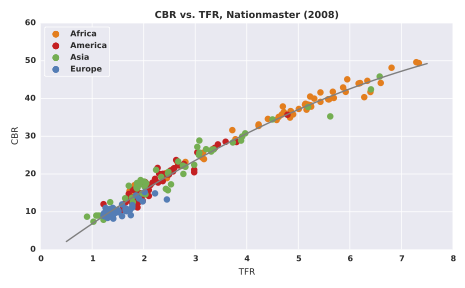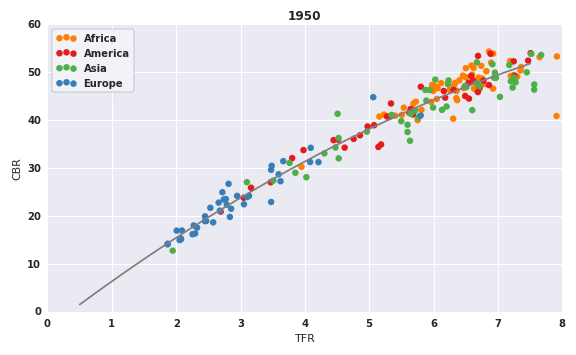Decay III: “Proportional transformation” of TFR data
18. marts 2015
In appendix 1 to the “Editor’s Note” Nyborg and Vig claim to have used crude birth rates (CBRs) arising from a so-called “proportional transformation” procedure. To be able to discuss this better, we need to define a formalism describing this transformation. Let
be a be a sequence of total fertility rate (TFR) data for countries $1…n$ e.g. from the United Nations World Population Prospects (WPP)
- Next, let
be a sequence of TFR data, for example from CIA (Nationmaster), and finally, let
be a set of crude birth rates (CBRs) for n countries, from the same source as $T$. The transformation:
creates a new sequence of values $B$ of the same order of magnitude as $C$ provided $U \approx T$. It is incorrect to call the transformation “proportional” since every datum is multiplied by a separate factor.
The reason for doing this transformation is obscure if the object is to obtain a set of $B$, because in order to do it, it is necessary to have a proper set of CBR data $C$, which is actual data and naturally should be used instead.
The reason the spreadsheet mmc1 deals with this meaningless transformation at all, is because it originally is designed to work with the so-called Alsager School data, for which only TFRs exist. Vig has used the Alsager data set (see the blog post Decay VI: The Alsager School data set) because he feels that the UN birth rate data is “too low, especially for people of third world origin” perspektiv.pdf p. 5.
Using a quadratic fit
There is no theoretical relationship between crude birth rates and the total fertility rate as they are completely different measures of fertility in a population. The crude birth rate is a sponge variable that soaks up many different effects. If for example, due to improved health care, the infant mortality is brought down, or if the average lifespan of the population goes up, the crude birth rate will drop. The crude birth rate is therefore exactly that: a crude measure. The total fertility rate, on the other hand, reflects the average number of children born to an average woman, if that woman lived her entire reproductive period within the one year that the statistics is aggregated. The total fertility rate is thus a more direct and meaningful measure of fertility than the crude birth rate. In addtion, the total fertility rate is more sensitive to changes in the fertility pattern.
There is, however, an empirical relationship between the two measures, shown in Figure 1. This is the reason the Vig’s tranformation works at all. If, for some very unusual reason, it is actually necessary to do this conversion, for example on historic data where only fertilities are available, a more rational approach would be to compute crude birth rates using a quadratic transformation obtained by fitting known data from a reliable source. Such a quadratic approximation is shown in Figure 1. However, from Figure 2 it is obvious that the quadratic changes year by year.


